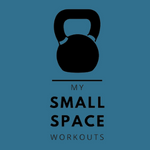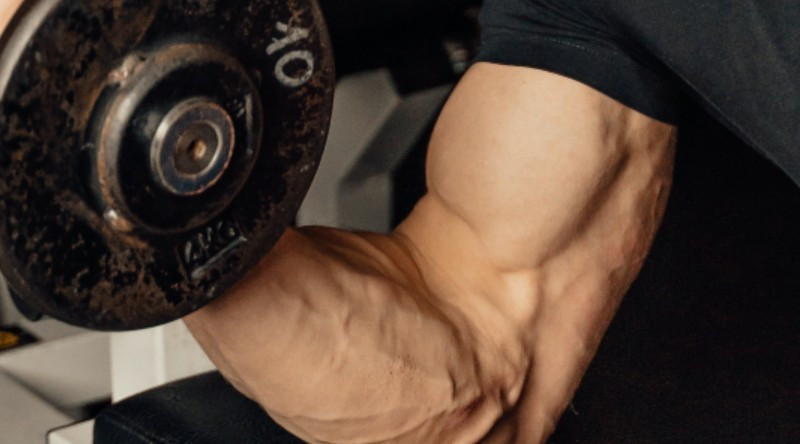
Hey you! If you’ve been training your arms like a maniac but still find yourself asking ‘why is my bicep not round?’ then you need to read this article. By the end of it, you’ll understand what’s been holding your biceps back and you’ll have a plan to smash through your current limitations as you learn the 3 main strategies we recommend for maximum bicep engagement. You’ll also learn to avoid the one fatal mistake that many bicep-boys make in their quest for shirt-busting biceps.
Don’t worry – you’re not going to be blinded by science in this article. But you are going be given simple, practical suggestions that WILL make a huge difference to your results.
In fact we’ve provided you with our very own ’round bicep workout’ which you can begin to implement today.
What Is a Bicep Muscle and What Makes It Round?
You’ll already know that the biceps muscle is located on the front of the upper-arm. It is used to help you pick things up and lift them toward your head and consists of two heads that work as one muscle.
The diagrams below illustrate the anatomy of the biceps.
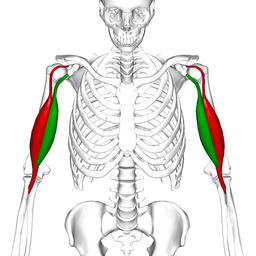
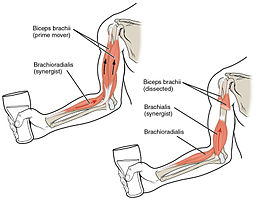
So we have the long head, the short head and in the following image, you’ll see the brachialis muscle, which underlies the biceps:
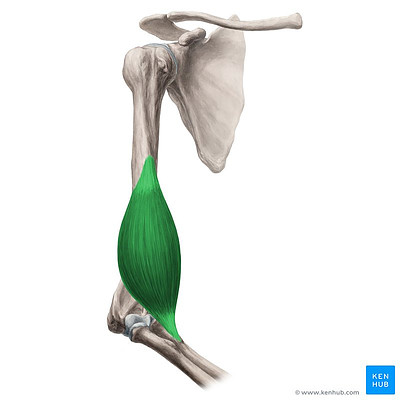
It’s the long head that contributes to peak and we’ve noticed that many bicep articles focus on exercises to engage this and then prescribe hammer curls to target the brachialis.
However, we don’t subscribe to this reductionist way of thinking, preferring instead to focus on overall muscle engagement and leveraging our endocrine system to drive growth.
Besides which, the anatomy education resource KenHub says about the brachialis:
“It is not affected by pronation or supination of the forearm”
Which calls into question the conventional wisdom which recommends using hammer curls to target this muscle.
What we can say however with certainty, is that both the biceps and the brachialis are engaged in the curling movement and both are important in achieving the round biceps that you have been working so hard for.
Why Are My Biceps Not Round?
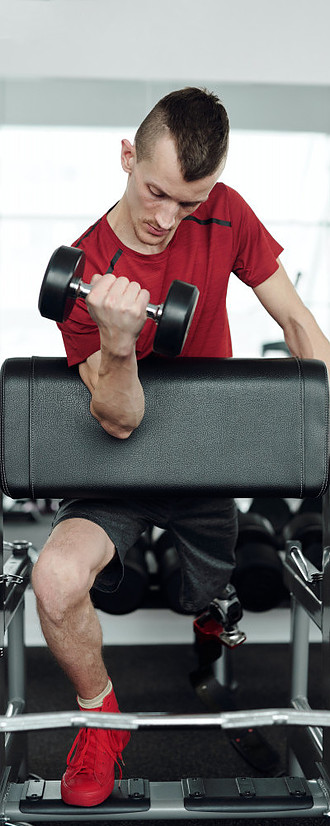
First of all, you need to rule out any medical reason why you’ve not been seeing the results you want.
So if you have any pain in your bicep or have noticed any strange bulges / malformation, this could signify a rupture. You definitely need to seek medical attention if this is the case. You also need to stop training immediately until you are cleared to workout by a medical professional.
If you are very overweight, this could be spoiling the aesthetics of your arm.
If this is you, you know what you need to do: reduce your calorie consumption, increase the frequency of your cardio-vascular workouts and make sure you’re doing plenty of lifting. Don’t worry, you’ll get to the round biceps workout a little later in this article.
Most often however, the people asking why are my biceps not round? simply have skinny arms that don’t seem to respond to their current training regime.
Can I Train My Biceps Every Day?
You can, but it’s counter-productive. It’s generally accepted that muscles take between 48 and 72 hours to recover from strenuous weight training. We find training Biceps on Tuesday and Back on a Friday to be an optimum way of structuring our workouts to ensure that biceps get toasted twice a week.
However, what happens when you do train biceps every day?
Thankfully, YouTuber Lauri Shaw has done a brilliant video where he challenged himself to do 100 bicep curls every day for 30 days!He stuck with it and at the end of his heroic endeavor his arms had grown by about just 1 inch. You should watch the video – but ignore his clickbait thumbnail – his biceps didn’t grow that much!!
That’s not a bad result, to be fair, but we believe you will experience more gains if you follow the tips throughout this article.
You’ll also be less likely to injure yourself and have more opportunity to train the rest of your body – which is critical for building a balanced physique.
On the topic of injury, you really don’t want to rupture your biceps tendon as this can lead to permanent biceps deformity. So as you progress through this article, keep in mind that you’re going to love, nurture and coax your biceps into growing. You’re not at war with them!
How to Get More of a Rounded Bicep
Okay, this is what you came here for. You want to learn the secrets of getting big, round biceps and we’re excited to share this with you – as we’ve not seen these techniques put together in this way before.
You’ll be training for both muscle size (hypertrophy) and muscle strength.
What we set out below are the core pillars of our biceps training process. We’ll deal with each one individually. They are listed in no particular order:
Include Seated Incline Dumbbell Curls
Studies have shown that considerably more neuromuscular effort is required throughout the whole elbow range of motion when performing a biceps curl with dumbbells while sat on an incline bench as compared to other types of biceps curl.
If you’ve ever performed incline dumbbell curls, you will have noticed two things:
- you can’t lift anything like the weight you can when performing standing curls
- the biceps are continually under tension through the entire movement (if performed correctly)
We don’t believe that there is any exercise that stresses the biceps muscles as completely as seated incline dumbbell curls. For this reason, the Incline Dumbbell Curl is the central pillar of our round bicep workout.
Include Chins on Back Day (Failure Sets)
Apart from your main bicep workout which should be undertaken once per week, we advise that you also hit biceps on your back day – which should at least 2 days after you biceps workout.
Chins are pull-ups performed with your palms facing your body. Essentially, you’re gripping the pull up bar as you would grip a barbell during a barbell curl.
Pull yourself up, squeeze the biceps at the top of the movement and return to the starting position at half the speed you pulled yourself up.
Throw a few sets of these in towards the end of your back workout and both your back muscles and your biceps will feel the burn!
If you can’t do chin-ups, throw in some cable curls instead.
Use Rest-Pause Training
Rest-pause training typically involves splitting up one set into several low rep sets with a short rest in between each set. It’s often used to break through growth ceilings and is widely regarded as an effective technique.
We’ve found that it makes the impossible, possible. It does this by enabling us to curl a heavy weight (around 90% of our 1 rep max) for 30 reps.
How is this possible?
- Once the biceps are fully warmed up, select your heavy weight and perform one rep.
- Put the weights down.
- Start a 12 second timer.
- Repeat 15 times.
That is one set. Rest for around 2 minutes and then repeat – aiming for another 15 reps.
Occlusion Training Finishers
If you haven’t already read our guide to occlusion training then please take 10 minutes to do so. You really don’t want to miss this information.
In brief, the reason that occlusion training is so important in your quest for boulder-biceps is that this training technique tricks the pituitary gland into releasing growth hormone.
If you don’t have a set of occlusion training bands, you may want to read our review of BFR Bands.
Putting all of the above into a routine may seem a little daunting. Don’t worry, we’ve taken all the above information and created a time-efficient bicep workout that should take no longer than 40 minutes to complete (30 minutes if you stick to the timing guidelines) and will train your biceps more effectively than you’ve probably ever trained them before.
The Round Bicep Workout
Because we’re focused on home-gym workouts which can be performed in any small space, we’re using equipment that doesn’t require too much space: adjustable dumbbells, a bench with incline adjustment and resistance bands.
You’ll also need some occlusion bands (check out our review of BFR bands here).
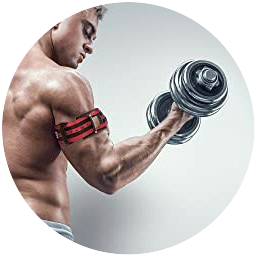
BFR Bands Review
We take a look at the most popular brand of occlusion training bands and discovering whether they should be an addition to your training equipment inventory.
Spoiler alert: if your biceps or glutes aren’t bulging as much as you’d like, then you need to read this review.
If you’re strict with your timings and stick to no more than 90 seconds of rest between sets, you’ll complete the entire workout in approximately 30 minutes. Don’t worry if you don’t hit the rep target either.
Do your best and complete the whole workout, lowering the weights if you need to. The % of your 1 rep max is based upon our own experience of following this routine and finding what works well for us, but feel free to adjust if you need to.
- Standing Barbell Curl (2 sets x 10 reps): This exercise is a classic bicep builder. Use a weight that is challenging but still allows you to maintain proper form throughout the set.
- Rest-pause Curls (2 sets x 30 reps): Use the rest-pause technique I describe above for this exercise. Use a weight that is around 90% of your 1 rep max and aim for 30 reps total, splitting them into mini sets of 15 reps with a 12-second rest in between each rep and a 2 minute rest between sets..
- Hammer Curls (2 sets x 10 reps): This exercise targets the brachialis muscle, which is located under the biceps and can help add width to your arms.
- Concentration Curls (2 sets x 10 reps): This exercise isolates the biceps and helps develop the peak of the muscle.
- Incline Bench Dumbbell Curls (2 sets x 10 reps): This exercise helps to emphasize the peak of the biceps by keeping them under constant tension throughout the set.
- Chin-ups (2 sets x 6-8 reps): Perform chin-ups as they’re a great exercise for targeting the biceps and overall upper body. Emphasize the negative phase of the movement by lowering yourself slowly and under control.
- Resistance Band Curls to Failure (2 sets): Finish with resistance band curls to really exhaust the biceps. Perform as many reps as possible until failure for each set.
Remember to warm up properly before beginning this routine, and always use proper form throughout each exercise. You can adjust the number of sets and reps to your fitness level and goals. Good luck with your bicep training!
Should I Consider Bicep Implants?
No. Do your best with your exercise and diet. Be consistent with your training and be grateful for the amazing body you have. Bicep implants look completely fake and – for want of a better word – weird.
Not only that, but this study revealed that complications occurred in 10 of 21 male patients who had received biceps augmentation. That’s 48% of the patients that had complications!
If you are considering spending thousands on cosmetic surgery, I’d advise you to put that money to some great equipment (check out our reviews in the sidebar) and throw yourself into a training plan instead.
Also, you need to understand that your biceps don’t define you, nor does your physique validate you as a person. We train because we enjoy it and want to be the best we can be physically. We don’t train because we seek security or self-esteem in what we see in the mirror.
So please, don’t take shortcuts and put the idea of surgery far from your mind.
Instead, embrace the strategies outlined in this article and work hard, consistently. We guarantee that you’ll make excellent gains if you couple this approach with a good diet.
If you’re still contemplating bicep implants then watch this poor guy talk to a cosmetic surgeon about the aftermath of his own bicep implant misadventure on the TV Series Botched.
Should I Consider Steroids to Get Big Round Biceps?

No. Please don’t use steroids. Many people don’t realise that there are ways to get steroid-like gains if they are prepared to implement some disciplined changes to their lifestyle.
If you want to understand what these endocrine-hacks are then make sure you check out our article on how to lower myostatin naturally.
Then you need to read our guide entitled What Is NoFap? And Why It Matters For Your Physique to learn how you can benefit from a spike in your own testosterone each week.
These two hacks, coupled with occlusion training will drive your body’s anabolic processes and you will see the results you’ve been missing out on.
Why would you want to inject yourself or swallow something that may cause you harm when you can benefit from nature’s finest and most effective anabolic steroids that are created within your own body and are completely safe?
Go Get Those Round Biceps!
So there you have it: everything you need to build some big, round biceps.
To summarize it’s important that you add incline dumbbell curls to your routine. You should also split your bicep and back training into separate workouts so that you hit your biceps twice per week. On back day, be sure to throw in some chins for a killer arm pump at the end of your workout! Finally, occlusion training – which is using blood restriction or tightness around an area during exercise – can flood the muscles of your arm with more blood than usual, promoting new growth over time. If you haven’t read it already, you can check out our complete guide on occlusion training by clicking the link below!
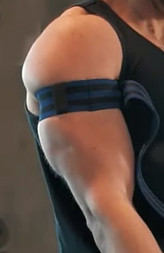
Does Occlusion Training Work?
Occlusion training has been growing in popularity in recent years, so you would be forgiven for thinking that it was a brand new technique. In fact, it has been around since the 1960s but the growing body of scientific evidence showing just how well it works has begun to catch the eye of elite sports teams.
